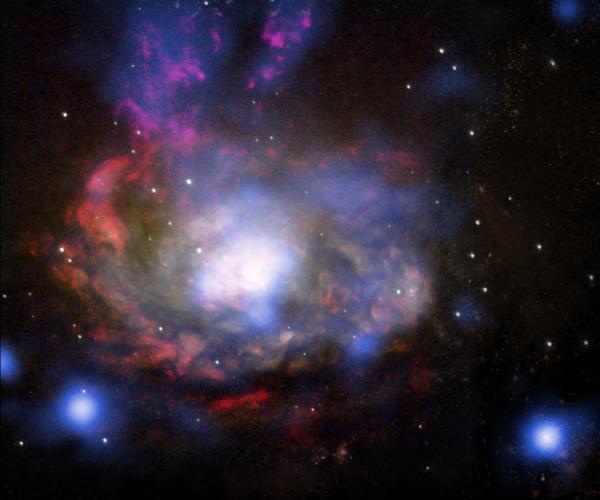The supernova of the wild cousin of SN 1987A
Astronomers have recently discovered that a relative of a strange exploding star was once thought to be unique in the universe. For more than two decades they have thoroughly studied supernova 1987A - an exploding star unlike any other star. Instead of becoming faded over time, 1987A is brighter by X-rays and radio waves.
Supernova SN 1996cr paid special attention to Franz Bauer in 2001. Bauer found a variable light source in the Circinus spiral galaxy as observed at the Chandra X-ray Observatory (NASA). Although the light source had exceptional characteristics, Bauer and his Pennsylvania colleagues could not confidently identify its nature at the time.
Several years later Bauer and his research team were able to confirm that the object was a supernova. The focal point for the VLT (ESO) ultra-large telescope spectrum has prompted the team to conduct detective work by searching data from 18 different telescopes both on the ground and in the Universe. cylinder. Almost all telescopes have information about strange objects. Because the object is detected in a nearby galaxy, the above telescopes have countless data stored about it.
SN 1996cr is among the brightest supernovae ever discovered under X-ray and radio light. It also bears many similarities to the famous supernova SN 1987A present in the 'neighbor' galaxy located only 160,000 light-years from Earth.
Bauer said: 'This supernova is probably the supernova cousin SN 1987A. The two supernovae are similar in many ways, but the newly discovered supernova is essentially thousands of times brighter than X-rays and radio. '
Archives from the Anglo-Australia Telescope in Australia show that SN 1996cr exploded around February 28, 1995 to March 15, 1996, but it was one of the last five supernovae within 25 The past year has not been observed after the explosion occurred a short period of time.

Above is a composite image showing the center of the nearby Circinus galaxy located about 12 million light-years away.Picture from Chandra X-ray Observatory (NASA) in green, and Hubble Space Telescope (NASA / ESA) image in yellow (band I), red (hydrogen emission zone), hexagonal (strip V) and light green (oxygen emission zone).The green light source near the lower right corner of the photograph is the SN 1966cr supernova, which was finally identified after it exploded over a decade.The supernova attracted the special attention for the first time in 2001, when it was a modified bright object but it was only recognized as a supernova many years later when the spectra were made by the Telescope. Very large VLT (ESO) provides clues that make the team embark on real detective work.They searched for data from 18 different telescopes located both on the ground and in the universe.SN 1996cr is one of the most recent supernova in the last 25 years.(Photo: X-ray (NASA / CXC / Columbia / F.Bauer et al); visible light (NASA / STScI / UMD / A.Wilson et al.))
Other orbital X-ray observatories such as ROSAT and ASCA did not detect SN 1996cr, but since it was first discovered by Chandra Observatory in 2001 it has gradually become brighter. Previously SN 1987A was the only supernova with an increase in X-ray volume over time. Bauer said: 'This is a miracle when detecting SN 1996cr, we will not be able to identify it without the telescope data. We really have entered the century; Internet astronomy ''.
The data combined with hypothetical research helped Bauer's team build a model to explode. Before the star exploded, it dispelled the surrounding gas to create a large chamber, which could be caused by the wind or from an explosion when it was at the end of life. Therefore the shockwave from the explosion can spread vigorously in that chamber without being hindered. Once the shockwave hits the surrounding dense material SN 1996cr, the impact causes the system to glow brighter when it emits X-rays and radio waves. X-rays and radio waves emitted in SN 1987A are fainter probably because the surrounding material is less dense.
Astronomers think that both SN 1987A and SN 1996cr provide evidence that the exploding star has a phase of photosynthesis before it explodes. These are also two examples of how this type of explosion can be quite common at the end of life of big stars.
Co-author Vikram Dwarkadas of the University of Chicago said: 'Our research shows that SN 1987A is not as monstrous as people think, but the study also tells us a lot about the big changes that the throne. Giant stars can go through life. '
Circinus galaxy is actually a very interesting object, it discharges into the surrounding gas belts. Circinus is located 13 million light-years from the Milky Way galaxy.
Refer:
FE Bauer et al.Supernova 1996cr: SN 1987A's Wild Cousin?The Astrophysical Journal, (in press)
- The light of the supernova explosion SN 1987A continued to shine
- Photos, videos and three-dimensional models of giant supernova
- The first evidence of the origin of cosmic dust formation
- Build 3D core map of a supernova
- Learn about supernovae and supernovae
- Discover new supernova
- Create supernova explosions in the laboratory
- The supernova explosion is 10.5 billion light-years away from Earth
- The supernova is 20 times brighter than the Milky Way
- Discover new forms of supernovae
- Supernova origin
- Earth used to catch supernova dust
 Van Allen's belt and evidence that the Apollo 11 mission to the Moon was myth
Van Allen's belt and evidence that the Apollo 11 mission to the Moon was myth The levels of civilization in the universe (Kardashev scale)
The levels of civilization in the universe (Kardashev scale) Today Mars, the sun and the Earth are aligned
Today Mars, the sun and the Earth are aligned The Amazon owner announced a secret plan to build a space base for thousands of people
The Amazon owner announced a secret plan to build a space base for thousands of people